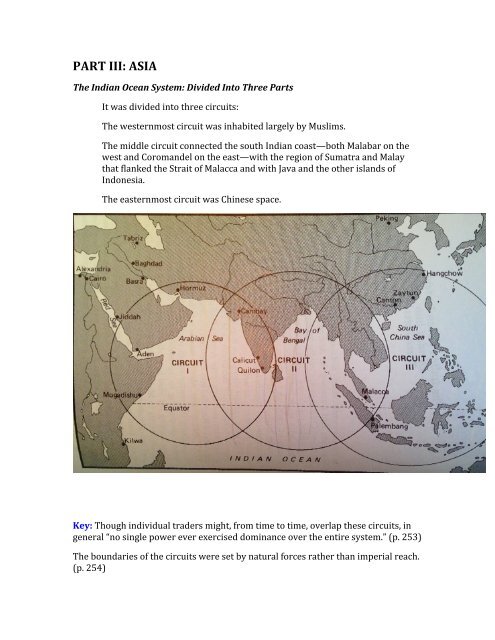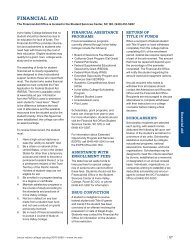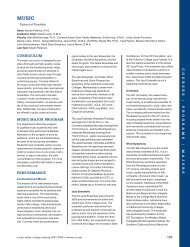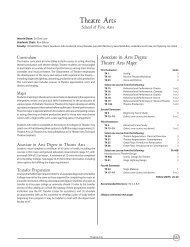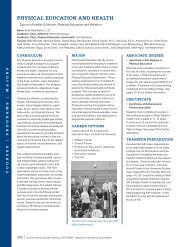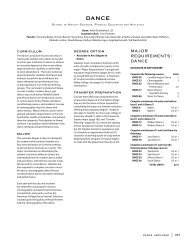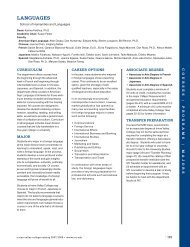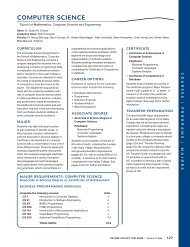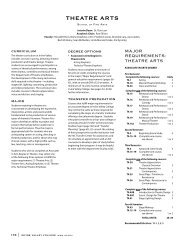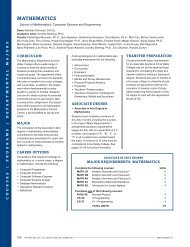Abu-Lughod Asia.pdf
Abu-Lughod Asia.pdf
Abu-Lughod Asia.pdf
You also want an ePaper? Increase the reach of your titles
YUMPU automatically turns print PDFs into web optimized ePapers that Google loves.
PART III: ASIA <br />
The Indian Ocean System: Divided Into Three Parts <br />
It was divided into three circuits: <br />
The westernmost circuit was inhabited largely by Muslims. <br />
The middle circuit connected the south Indian coast—both Malabar on the <br />
west and Coromandel on the east—with the region of Sumatra and Malay <br />
that flanked the Strait of Malacca and with Java and the other islands of <br />
Indonesia. <br />
The easternmost circuit was Chinese space. <br />
Key: Though individual traders might, from time to time, overlap these circuits, in <br />
general “no single power ever exercised dominance over the entire system.” (p. 253) <br />
The boundaries of the circuits were set by natural forces rather than imperial reach. <br />
(p. 254)
See pp. 256-‐57 for tables on winds/sailing conditions and times of year. <br />
When the Chinese (Ming Dynasty) withdrew from the sea in 1435, it created a <br />
power vacuum that would be filled by the Portuguese. <br />
Chapter 8: The Indian Subcontinent: On the Way to Everywhere. <br />
India has two macroecological zones: the Malabar Coast and the Coromandel. <br />
Sea trade to and from Gujarat, and possibly the Malabar Coast was already <br />
happening in 2000 BCE. <br />
The Abbasids were revitalizing this route in the 8 th century CE.
In the Mediterranean a perpetual state of naval warfare existed from the ninth <br />
century onward, and commercial ships, therefore, always traveled in military <br />
convoys. That was not true in the Indian Ocean since sea warfare did not <br />
characterize commerce there. The trade was essentially peaceful. (p. 275) <br />
It was a system of laissez-‐faire and multiethnic shipping, established over long <br />
centuries of relative peace and tolerance. In December 1500 the Portuguese captain, <br />
Cabral decided to attack and seize two Muslim ships loading pepper at Calicut. He <br />
was “sinning” against an “unwritten law.” (p. 276)
This use of violence, force, and extortion characterized the Portuguese approach in <br />
the early 16 th century. <br />
Lessons from the Indian Case <br />
India seems to have been indifferent to much of the items traded. <br />
Indian wealth kept her from being more aggressive in being involved in the <br />
sea trade. <br />
This meant that she was vulnerable to the expansion of sea power on either <br />
side of her.
Chapter 9: The Straight and Narrow <br />
The entrepot’s on the straight were important, but geography was somewhat <br />
arbitrary. Any port along the straight could have become an important <br />
intermediary. <br />
Sometimes, as in the case of Srivijaya, representatives could become important <br />
because they gained access to Chinese ports.
Lessons from the Straits: <br />
Comprador states that serve as gateways or interchange points for others are <br />
fully dependent upon the industrial production and commercial interests of <br />
the regions that use them. <br />
The existence of locally produced assets (even aromatics, spices, and <br />
precious metals) by no means guarantees a market; it only makes one <br />
possible. <br />
Whenever the Chinese moved aggressively outward, the intermediary ports <br />
paradoxically became more prosperous but less important. Whenever the <br />
Chinese pulled back from the western circuit or, even worse, interdicted <br />
direct passage of foreign ships into their harbors, the ports in the straits <br />
flourished, but only because Chinese vessels took up the easternmost circuit <br />
slack by meeting their trading partners at Palembang, Kedah, or, later, <br />
Malacca. <br />
When Europe filled that defenseless vacuum in the sixteenth century, the <br />
‘old’ world system of the thirteenth century became the embryo of the <br />
‘modern’ system that still shapes our world today, albeit with declining <br />
power. (p. 313) <br />
Today, Singapore most closely resembles its predecessor, Malacca.
Chapter 9: All the Silks of China <br />
Without question, the most extensive, populous, and technologically <br />
advanced country of the middle ages was China. <br />
<strong>Abu</strong>-‐<strong>Lughod</strong> questions the usual interpretations that see the Chinese as anti-merchant,<br />
especially if that is used as an explanation for their withdrawal <br />
under the Ming Dynasty. <br />
Furthermore, historians have pondered what would have happened if China <br />
had not withdrawn? What if the Portuguese met a Chinese navy instead of <br />
undefended merchant vessels? <br />
Factors related to textile production: <br />
Wool. The demand for grazing land comes into competition with land <br />
for agriculture, thus displacing farmers whose labor is made available <br />
for processing the wool—women largely spinning and men <br />
predominantly fulling, dyeing, and weaving. Wool is easily <br />
transportable in its raw state, which permits a separation between <br />
where it is raised and where it is transformed into cloth. <br />
Cotton and linen follow a different course. Agricultural land remains <br />
under cultivation and crop rotation (with legumes) is required to keep <br />
the soil fertile. This means that there is neither a division of labor <br />
between cotton and flax growers and ordinary farmers nor any <br />
displacement of labor from the land. The raw materials may be <br />
transported for further refining or may receive preliminary <br />
processing and cleaning before being shipped to spinners and <br />
weavers. <br />
The production of silk is very different. It involves a large portion of <br />
rural workers who must be close to the processing area. This leads to <br />
the establishment of agro-‐urban settlements. See pp. 329-‐330 for a <br />
description of the process. This process was not easily transferred to <br />
factories. <br />
Why China Withdrew <br />
It’s often blamed on Confucianism, but why would Confucianism have <br />
been more important under the Ming? <br />
She thinks it is due to the Ming desire to present themselves as the <br />
restorers of Chinese autonomy and values after Mongolian rule. <br />
They also had to divert attention elsewhere as they consolidated their <br />
rule. <br />
The Black Death also contributed to a general economic collapse.
Lessons from the Chinese Case <br />
Geographic position was very important. When the Mongols created <br />
the northern route, China was the place were the circuit could be <br />
complete, as it had sea routes linking to the Indian Ocean.


